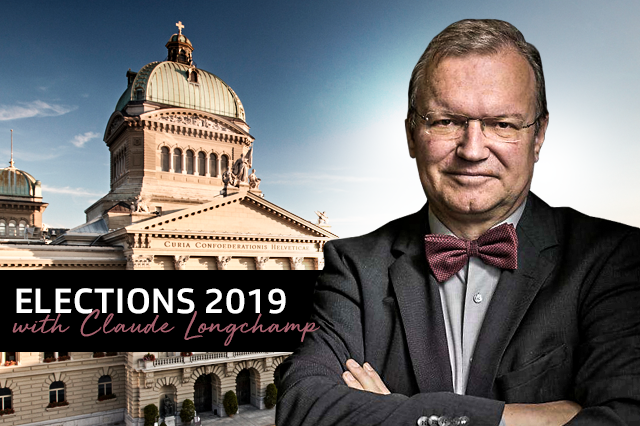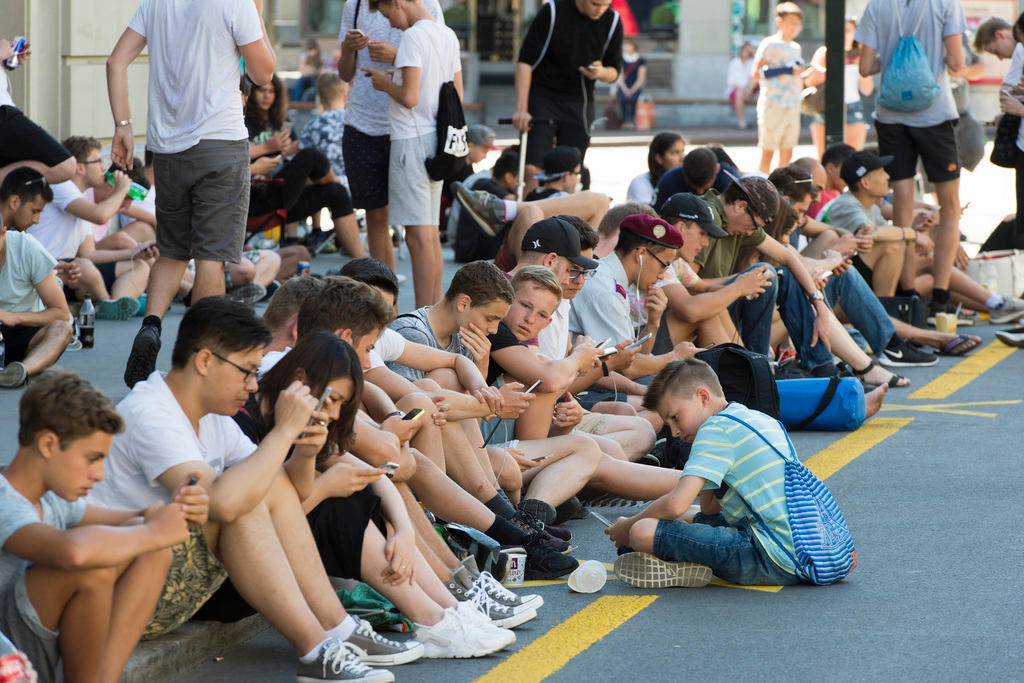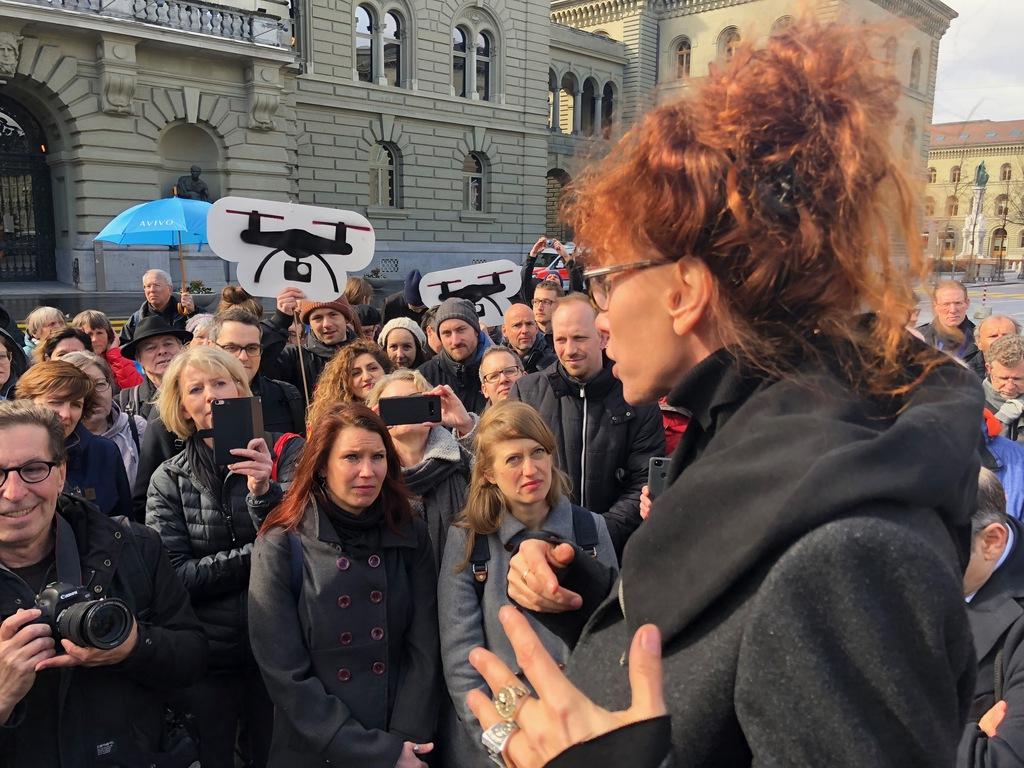Recruiting voters to be part of the campaign

Traditional politics has relied on influencing public opinion largely through the press. The new politics is all about mobilising crowds.
Does this mean the end of political discourse as we know it? Hardly. But campaigning for Switzerland’s next parliamentary elections is going to be different from what we have ever seen before.
A press release from Zurich University recently created a stir: “Disappearing media are a threat to democracy,” it was headed. It quoted a political science study which claimed to show that turnout for local votes depends directly on the (dwindling) local media.
This claim revealed a significant assumption. Our current understanding of political campaigning is based on the idea that information provided through the press is what citizens need to form their opinion.
Claude Longchamp is a senior political expert and one of Switzerland’s most experienced and highly-regarded political scientists and analysts.
He founded the polling and research institute GfS BernExternal link, which he headed until his retirement. Longchamp has analysed and commented on votes and elections on SRF public Swiss television for 30 years.
Longchamp also runs two German-language blogs: ZoonpoliticonExternal link on political issues and StadtwandererExternal link with contributions about historical topics.
This text is part of #DearDemocracy, a platform on direct democracy issues, by swissinfo.ch. Contributors, including outside authors frequently share their views. The opinions expressed here are not necessarily those of swissinfo.ch.
The call by the study’s authors to foundations, parties and government agencies to become active in the media world themselves in order to protect democracy, sounded rather like the counsel of despair.
I find that a book which appeared around the same time entitled, Agenda for a digital democracy, has more constructive ideas to offer. In this book, campaigner Daniel Graf and political scientist Maximilian Stern explore the potential for digitalisation of political communication.
The authors do not shy away from the issue of who is likely to rule digital Switzerland. Their answer is: a digital party of the younger generation which does not yet exist, but whose profile is already emerging.
Voter is part of campaign
Since the remarkable No-campaign against the Swiss People’s PartyExternal link 2016 proposal to enforce an initiative on the deportation of criminal foreigners, this issue has been discussed using the example of the nonpartisan Operation LiberoExternal link movement.
These new-style campaigns operate quite differently from traditional campaigns, in which a campaign spokesman at the centre addresses himself top-down to recipients. The goal of the new-style campaigners is to make the recipients themselves spokespersons. They are to work on their own environment and thus have a greater effect.
That is one piece of good news from Graf and Stern’s book.
Less fact, more emotion
The other trend that gives real food for thought, however, is the major change in the nature of political communication.
What is now in demand is not rational argument between spokespersons for both sides, to convince the undecided to vote for one party rather than another, or to vote for or against a referendum proposal or an initiative.
The aim of the newer campaigns is rather to use individualised media and energise a core of potential voters who have already made up their minds, so that they vote with added emotional vehemence.
Mobilisation is the new trend – not making or changing public opinion.
“It is not in-depth information that counts, but rather the potential for creating ‘fan’ communities.”
Energising stories gain traction
Graf and Stern compare the emerging kind political communication with a game of billiards, in which a powerful whack hits the most exposed ball as directly as it can, so that its energy sets the billiards behind it in motion. Ideally, these should scatter in every conceivable direction.
Marketing experts call this the “first follower principle”.
At the start there may be just one person, who tells their story in such a way that other people feel motivated to tell theirs. If this trend continues, it becomes a movement.
The best example of this is the #MeToo movement, in which women came forward with stories of sexual abuse. At the start of the wave was the well-known American actress Alyssa Milano, who accused film producer Harvey Weinstein.
With Twitter and Facebook the story went viral around the world. In many countries the message also took over radio and TV and was widely discussed in the press. Both old and new media were decisive for the global spread of the movement.
Challenge for political parties
For parties as well as initiative and referendum committees, the issue is to intensify their communication efforts.
Graf and Stern advise interested readers, besides the usual PR work and extensive advertising, to focus on “crowd” campaigns.
Such campaigns zero in on “multipliers” between the central source and the target groups.
These absorb the party’s message and then re-transmit it, suitably adapted to their particular environment.
No need for in-depth information
The world’s leading communication experts like Joel Penney call such people “citizen marketers”. Their outstanding feature is that they adopt clear positions, live their values authentically, and may have many who think like them on social media.
It is not in-depth information that counts, but rather the potential for creating “fan” communities.
First Swiss Twitter referendum
Book co-author Graf is himself a force in the opposition to the proposed legislation aimed at cracking down on suspected welfare fraudsters in Switzerland. He really operates according to these scenarios and speaks from experience.
Four associates of his working outside the political institutions have forced a referendum against the controversial “spies” which the government wants to curb social welfare and insurance fraud.
The most prominent spokeswoman on Twitter was the writer Sybille Berg. With a group of allies, she sought 5,000 collectors who undertook to bring in ten signatures each.
And the strategy worked – in part, because of enormous interest on the part of the mass media in this first “Twitter referendum” ever. After only 60 days the goal was reached. As a result, the issue is likely to come to a nationwide vote in November.
No reason to despair
One may regret the decline of the mass circulation press. There can be no doubt as to the decline of the mass media’s power to inform and sustain discussion about issues and people.
Exaggerated pessimism (as in the academic study cited at the beginning of this article) is, however, out of place, in my view.
Because beyond the eclipse of the traditional press, a trend towards mobilisation of opinion energisers is emerging with the digital media.
What exactly will happen in the 2019 parliamentary elections in Switzerland is hard to foresee. Some things are known, such as that “crowd” campaigns are to be launched, to reach out to other opinion-makers.
It remains to be seen, however, whether the entire range of voters can be influenced in this way. Most likely there will be a mix of traditional PR work, advertising, and new-style mobilisation.
Translated from German by Terence MacNamee

In compliance with the JTI standards
More: SWI swissinfo.ch certified by the Journalism Trust Initiative




You can find an overview of ongoing debates with our journalists here . Please join us!
If you want to start a conversation about a topic raised in this article or want to report factual errors, email us at english@swissinfo.ch.